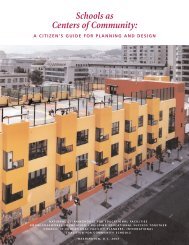A History of School Design and its Indoor - National Clearinghouse ...
A History of School Design and its Indoor - National Clearinghouse ...
A History of School Design and its Indoor - National Clearinghouse ...
You also want an ePaper? Increase the reach of your titles
YUMPU automatically turns print PDFs into web optimized ePapers that Google loves.
18 A <strong>History</strong> <strong>of</strong> <strong>School</strong> <strong>Design</strong> <strong>and</strong> <strong>its</strong> <strong>Indoor</strong> Environmental St<strong>and</strong>ards, 1900 to Today<br />
These open plan schools were not introduced blindly,<br />
but were accompanied by some thorough research.<br />
Weinstein reports on one open-plan school that had already<br />
received retr<strong>of</strong>i t treatment by 1979, <strong>and</strong> the effects<br />
<strong>of</strong> the retr<strong>of</strong>i t had been measured, although the study<br />
<strong>its</strong>elf had not been published (<strong>and</strong> could not be found<br />
today). Researchers found that the modifi cations <strong>of</strong> variable-height,<br />
sound-absorbent partitions between classrooms<br />
signifi cantly reduced classroom interruptions <strong>and</strong><br />
increased substantive, content questioning (Wienstein,<br />
1979, p. 582). However, she also recognizes that much<br />
<strong>of</strong> the research on open-plan schools was confl icting, <strong>and</strong><br />
as such, she cautioned the reader, “[a]t the present time,<br />
it is still necessary to suspend judgment about the success<br />
or failure <strong>of</strong> the open space school to enhance the<br />
educational experience <strong>of</strong> children” (ibid, p. 598).<br />
Another project that brought attention to the EFL was<br />
the <strong>School</strong> Construction Systems Development Program<br />
(SCSD), which was a major effort to bring prefabricated<br />
construction techniques to school construction. The<br />
program was largely a joint effort between researchers<br />
at Stanford University <strong>and</strong> the University <strong>of</strong> California<br />
at Berkeley, <strong>and</strong> was seen by many to be a major contribution,<br />
with one retrospective calling it, “clearly the<br />
major experimental building program <strong>of</strong> the sixties. The<br />
methods, procedures, <strong>and</strong> hardware systems developed<br />
as a result have had a pr<strong>of</strong>ound infl uence on American<br />
design <strong>and</strong> construction” (R<strong>and</strong> <strong>and</strong> Arnold, 1979, as<br />
quoted in Marks 2009). SCSD “sought to apply industrial<br />
techniques <strong>of</strong> st<strong>and</strong>ardization <strong>and</strong> systems analysis in an<br />
attempt to develop a new <strong>and</strong> more economical building<br />
technology (Boice, 1968).” It involved, <strong>of</strong>fi cially, 12 secondary<br />
schools <strong>and</strong> one elementary school in California,<br />
but 1300 schools in California contain a subsystem developed<br />
through the SCSD program (Griffi n, 1971). Most<br />
<strong>of</strong> the systems described seem to be related to structure<br />
<strong>and</strong> envelope, but it is unclear whether any <strong>of</strong> these systems<br />
are still in use today.<br />
5.1 Energy consumption trends<br />
Following the energy crisis <strong>of</strong> 1973, energy codes<br />
<strong>and</strong> regulations began to radically change the priorities<br />
<strong>of</strong> school facility pr<strong>of</strong>essions, towards the need to<br />
reduce energy consumption above all other priorities.<br />
It was during this time that school designs <strong>and</strong> renova-<br />
tions capitulated to the relative simplicity <strong>of</strong> relying on<br />
mechanical systems to provide requisite lighting <strong>and</strong><br />
thermal conditions. Since it was also a time when few<br />
new schools were being built, the focus was on the<br />
energy-effi cient renovation <strong>of</strong> existing schools, especially<br />
those from the early parts <strong>of</strong> the century. While this had<br />
<strong>its</strong> benefi ts, there were many unfortunate decisions made<br />
at this time, in particular in regards to windows. <strong>School</strong>s<br />
like the H.B. Plant High <strong>School</strong> in Tampa, Florida, built in<br />
1927, had many <strong>of</strong> their large windows closed <strong>of</strong>f to save<br />
heating <strong>and</strong> cooling energy, since they were no longer<br />
necessary to provide light to classrooms. As Hille notes,<br />
this common practice “severely impacted the quality <strong>of</strong><br />
natural light, natural ventilation, <strong>and</strong> in general, the sense<br />
<strong>of</strong> indoor-outdoor connectivity- all <strong>of</strong> which were mainstay<br />
characteristics <strong>of</strong> the modern school” (Hille, 2011, p.<br />
163). These decisions are largely being reversed today,<br />
<strong>and</strong> the Plant High <strong>School</strong> <strong>and</strong> many others are seeing<br />
their historic windows restored (at a great cost, <strong>of</strong> course-<br />
the total renovation cost for the Plant school was $12<br />
million) (Kennedy, 2003).<br />
The energy crisis also served as the impetus for the<br />
largest federal energy-related building retr<strong>of</strong>i t program<br />
in history, the Institutional Conservation Program, also<br />
known as the <strong>School</strong>s <strong>and</strong> Hospitals program, which was<br />
initiated in 1977. This program built signifi cant awareness<br />
at state <strong>and</strong> local levels about the importance <strong>of</strong><br />
energy conservation in school buildings. This federally<br />
supported effort brought the issue <strong>of</strong> wasted energy to<br />
the nation’s attention, <strong>and</strong> spurred signifi cant research<br />
into other means <strong>of</strong> saving energy in schools.<br />
5.2 Evaluation <strong>and</strong> st<strong>and</strong>ards<br />
5.2.1 Ventilation, Heating <strong>and</strong> Air Quality<br />
The 1960s <strong>and</strong> 1970s saw many changes in st<strong>and</strong>ard<br />
practice <strong>and</strong> common wisdom in classroom thermal<br />
comfort <strong>and</strong> air quality. Of course, at the time, scholars<br />
<strong>and</strong> authors <strong>of</strong> relevant texts showed no signs <strong>of</strong> doubt<br />
as to the validity <strong>of</strong> current knowledge on these matters.<br />
For example, one architect from the period writes, “[u]<br />
ntil recently, schools in many areas have been overventilated.<br />
The old rule <strong>of</strong> thumb specifying that every<br />
classroom provide 30 cubic feet <strong>of</strong> fresh air per minute for<br />
each student is now being replaced by fresh air require-<br />
<strong>National</strong> <strong>Clearinghouse</strong> for Educational Facilities<br />
a program <strong>of</strong> the <strong>National</strong> Institute <strong>of</strong> Building Sciences<br />
1090 Vermont Avenue, N.W., Suite 700, Washington, DC 20005-4950 202-289-7800 www.ncef.org © 2012, <strong>National</strong> Institute <strong>of</strong> Building Sciences










